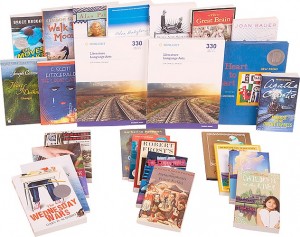Character, culture, plot, emotion, language. Only two or three books per hundred meet all of these tough criteria!
If you ever need to choose truly memorable fiction books, whether for yourself, your children, or your school, you could do worse than add these seven benchmarks to your arsenal.
Sarita Holzmann, of Colorado-based home education supplier Sonlight Curriculum, reviews fifty books every week, and the following seven tests are the first hurdle she imposes on every work of fiction. (She has now been choosing the very best books she could find for educators for 25 years, since February 1990.)
As Sarita explains on the Sonlight Curriculum website:
Except in rare circumstances, every book in the Sonlight catalog has to pass the following 7-point test:
- Real/realistic characters. Heroes should not be flawless. Anti-heroes ought not to be thoroughly detestable. They need to be nuanced and complex—the way real people really are.
- Solid character development. The protagonist must change (for the better) over the course of the book.
- Content that adds to the reader’s cultural literacy. The book’s plot, setting, characters, or vocabulary—something—must contribute to a reader’s knowledge about world events and cultures, or their understanding of “the way things work” in human relations … in life.
- Intriguing, multi-dimensional plot.
- Emotionally compelling. The story has to move me.
- Verbally beautiful. The writing must be superb and allow for fluent reading—silently or out loud.
- Re-readable. You have to want to read it over and over again.
The only time I ignore these rules is when there’s a subject we have to address and absolutely no book meets these seven criteria. I’ll put a lesser book in the spot only until I find a better one. You may be sure I stay away from trite, formulaic books. I also avoid the dry-as-dust tomes that merely recount “facts and figures” — the kind of books that exist solely to pump young minds full of information.
At this point in my life, out of every hundred books I read, I find only two or three that might merit becoming part of one of our programs. That’s how few books there are that have the depth, the beauty, the cultural sensitivity, the inspiration, or the winsome, scholarly character I am looking for.
Sonlight Curriculum consequently produces some very engaging literature-centred K-12 teaching packages for home educators, as well as seasonal reading packages for various ages.
Encouraging our children to read prolifically is one of the great gifts we can give them. Good choices of books can make all the difference between a child developing a love of reading, or else never getting over early experiences with books that were too hard, age inappropriate, or that never quite spoke to them.
To browse Sonlight’s book choices, or download a PDF catalog, visit Sonlight.com


